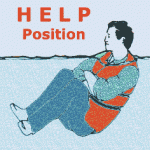I’ve always been surprised by the number of email questions I receive at my web site about lightning. When you compare the 90 or so total deaths each year from lightning strikes in the United States to the 600 or so PFD-less drownings during a similar time period, you would think that boaters would be far more interested in why they should be wearing life jackets. But lightning apparently holds a deeper fascination than vests for most people. And I guess that’s proven by the fact that hardly anybody stays up half the night during a thunderstorm waiting for just that one critical instant when they can photograph a type III PFD.
I also know that lightning is more fascinating than PFD’s by the fact that there are many groups and institutes studying lightning, and hardly any looking at a way to get more people to wear life jackets. Without much research at all, you’ll find the LPI. (Lightning Protection Institute), the NLSI (National Lightning Safety Institute), and the ABYC (American Boat and Yacht Council), just to name a few.
If you cruise around the Internet, you’ll even see web sites published by and for lightning survivors. People tell stories of how they’re now broadcasting classical music from their fillings after taking a 50,000,000-volt hit. Can you blame people for finding that fascinating? For some reason, I can’t find a single web site of testimonials from people who had a near drowning experience while their life jackets remained stuffed in a locked storage locker.
So I guess it’s time that I yield to the pressure, take a pause from my compulsive advocacy to see life jackets on all boaters, especially kids, and give you some of my observations about?lightning.
First of all, there are some things about lightning that may surprise you.
1. Although three-quarters of the surface of the earth is covered by water, there are significantly more lightning strikes over land. This should provide some solace to those who have an unnatural fear of being vaporized at the helm.
2. The average length of a lightning bolt is six miles. This doesn’t mean that if you’re seven miles from a storm you should climb the mast and wave a copper plate in the air with one hand whilst thumbing your nose at the clouds with the other. On the other hand, unpredictable as lightning seems to be, it might not make a difference.
3. Having a lightning protection system on your boat (a masted cone of protection with heavy copper bonding straps and a massive copper plate nailed to the hull) will not prevent a lightning strike. It may even increase the possibility of a strike. But what it probably will do is minimize damage to the boat and the boat’s people if you do get hit. That’s a good enough reason to consider lightning protection on your vessel.
The thing to remember is that there are no absolutes with lightning, on land or on the water. And when dealing with an element of such power, such energy and such unpredictability, a prudent individual will do everything possible to avoid it.
A group of Power Squadron members from my town were on the Tom Bigby several years ago, and pulled into a little sheltered area one afternoon to wait out a thunderstorm. They anchored their three boats side by side in the backwater and watched as the storm approached their area. A lightning bolt struck the water some distance away, and discharged in all directions across the surface of the water. The boat nearest the discharge had a hole blown in the hull about three inches in diameter at the waterline. The middle boat suffered no damage whatsoever, and the boat furthest from the strike had hundreds of pinholes and blisters across a large section of the vessel’s port side. Unpredictable? I’d say.
Remember, the best way to manage the risk of lightning is by avoidance. If you see a storm approaching, and can get off the water, do it. If you can’t, put on lifejackets, keep your passengers low in the boat and clear of electronics, cables and conductive metals. If there’s a wind with the storm, head into it. If you’re being pushed toward a dangerous situation, or shore, lower an anchor from the bow and play out lots of anchor line. Here, like in most things in life and in boating, common sense goes a long way toward getting you and your passengers home safely.
Now, grab your camera, put on rubber-soled shoes, take off all your jewelry, and go out and see if you can find a life jacket to photograph.








